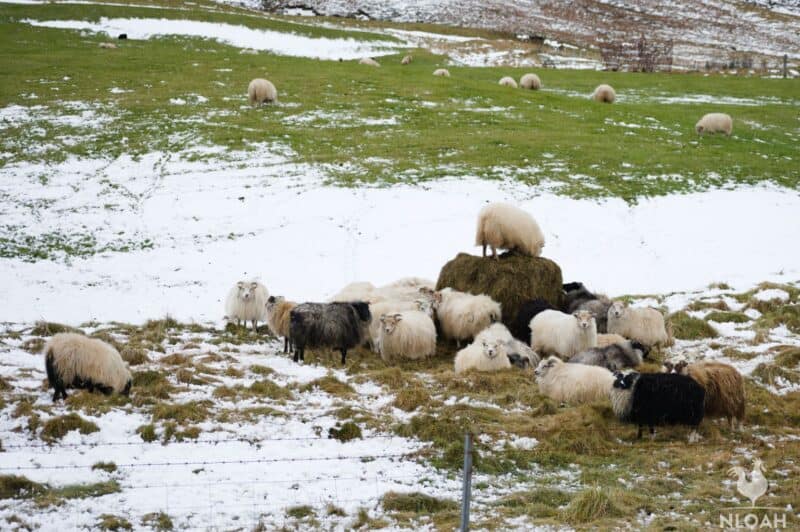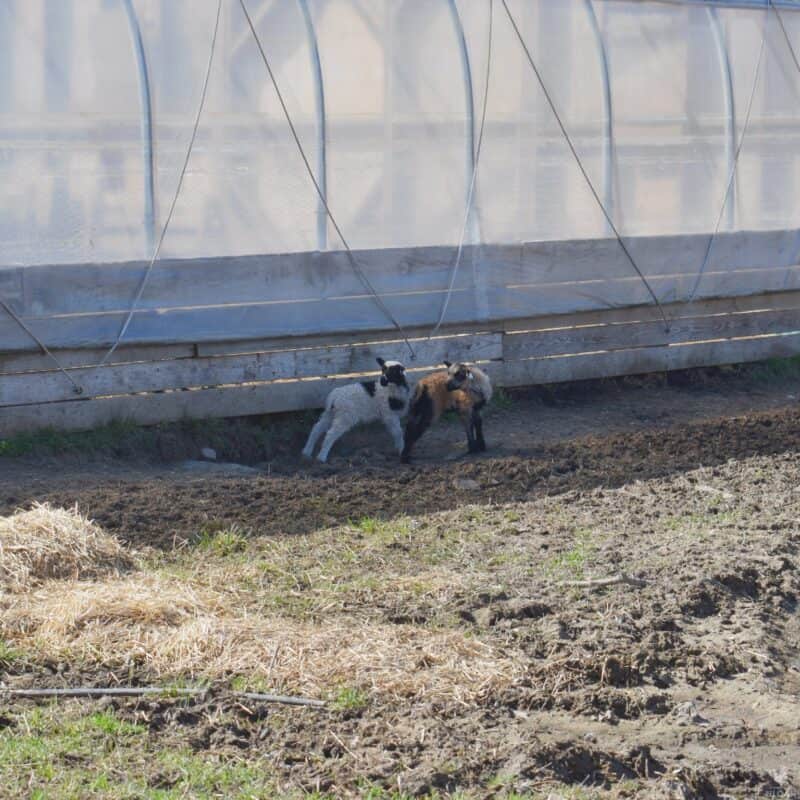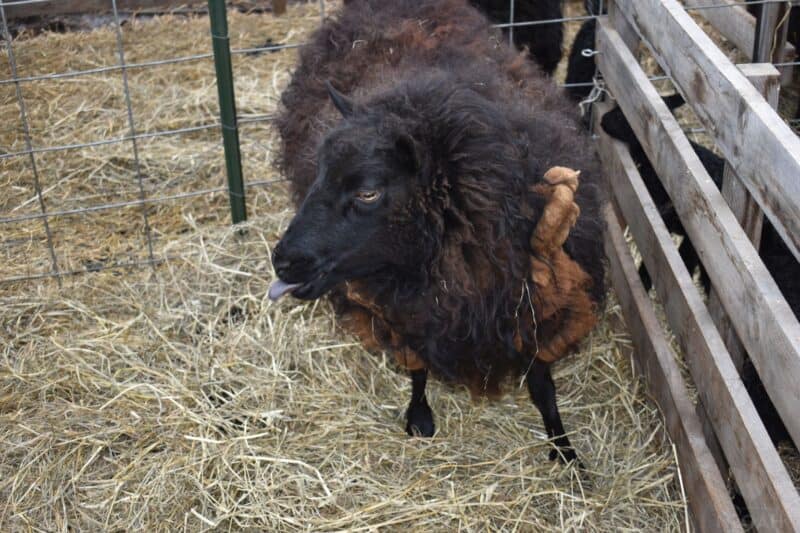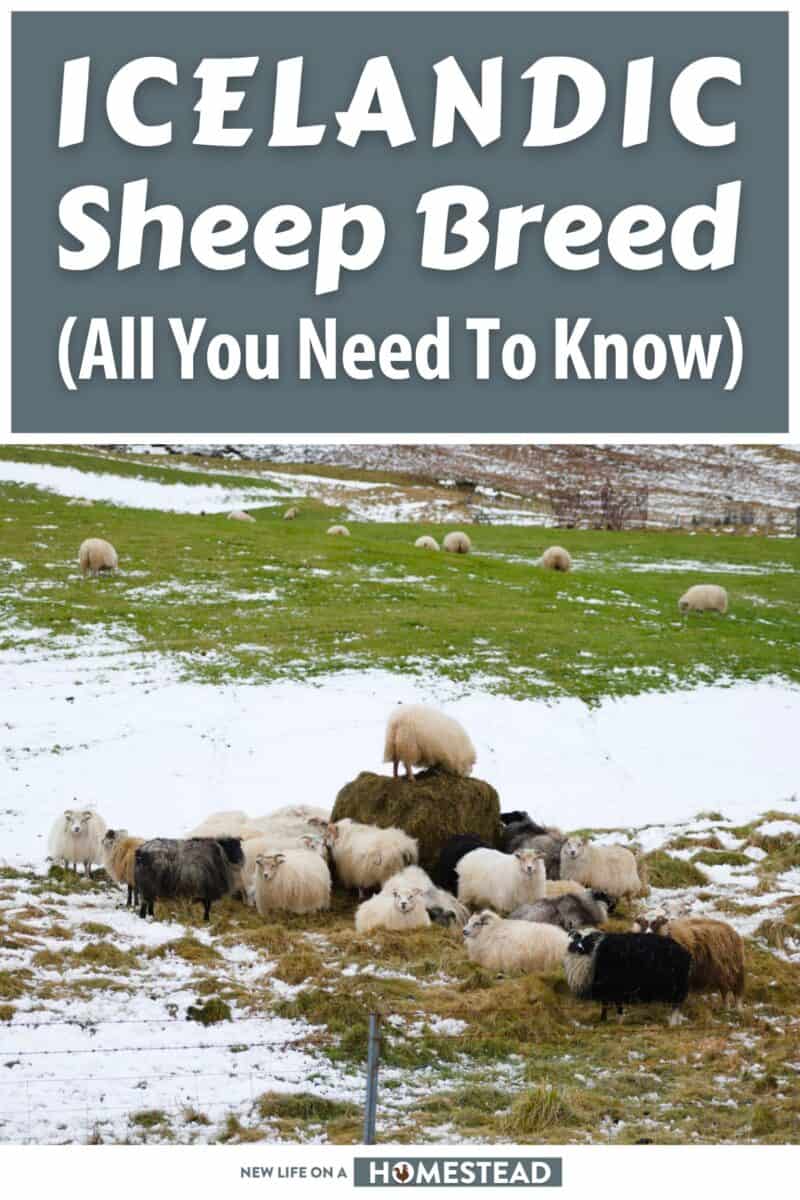The Icelandic sheep is a hearty breed that has been used for centuries to sustain the people of Iceland. They are able to thrive in cold, harsh climates due to their thick coats of wool and hardy constitutions.

Icelandic sheep are also well known for their high-quality fleece, which is often compared to merino wool in terms of softness and warmth. The fleece can be used for anything from sweaters and blankets to socks and hats.
We have been raising Icelandic sheep on my farm for more than four years now, and our flock numbers are nearing the hundreds! We use them for meat production as well as for solar grazing at a nearby solar farm.
They’re well-suited to these purposes, as they produce tender, flavorful meat – and are also quite adept at “vegetation management”, helping to keep the brush down so the solar panels can work properly to the solar company we’ve hired them out too.
That said, you can also raise Icelandics for their fiber and for their milk. Although we don’t do this, they’re fantastic for this purpose.
We’ve added some other sheep breeds to our flock but make sure most of our flock is Icelandic since we love this breed so much.
If you’re interested in adding an Icelandic sheep to your flock, there are a few things you should know first. Read on to learn more about these amazing animals!
Characteristics
The Icelandic Sheep is a member of the North European short-tailed sheep group, which includes several other North Atlantic island breeds. These sheep are distinguished by their small size, short tail, and stocky build.
The breed was developed in Iceland over many centuries, and its characteristics have been shaped by the island’s harsh climate and limited resources. Icelandic sheep are thrivable and adaptable, able to withstand long periods of cold and darkness. They are also good foragers, able to find food even in the snow.

Size and Weight
The average Icelandic lamb, at market size, will be between 60 and 100 pounds. They have a relatively average build. Mature ewes typically weigh around 100 to 170 pounds while rams can be as heavy as 250 pounds.
Wool/Hair
The Icelandic sheep is a unique breed of livestock that is prized for its wool and hair. The most notable feature of the Icelandic sheep is its double coat, which consists of a dense inner layer of wool and a thinner outer layer of hair.
This combination provides the sheep with excellent insulation against the cold, windy climate of Iceland.
The outer layer of hair also helps to repel moisture, making the Icelandic sheep an ideal choice for wet or humid conditions.
The fleece of the Icelandic sheep is highly sought after by spinners and weavers due to its softness, density, and lustrous sheen.
Furthermore, the fleece of the Icelandic sheep contains no kemp or guard hairs, making it exceptionally easy to clean and process.
Horns
In addition to its double coat, the Icelandic sheep is also characterized by its long, curved horns, which are common in uncastrated rams.
Even some ewes have horns! These horns are not found on all sheep, as there are many polled varieties of Icelandic sheep, but they can make for easier handling and a gorgeous overall appearance.

Icelandic Sheep Breed Temperament
Icelandic Sheep are a unique breed that is known for their independent nature. These sheep were dropped off on the island of Iceland by the Vikings and left to fend for themselves.
As a result, they have developed a very independent streak and are not known for their flocking tendencies.
Icelandic Sheep are also known for being good mothers. They will fiercely protect their young from predators and will do whatever it takes to keep them safe.
However, Icelandic Sheep can also be skittish and flighty. They can be easily scared by loud noises or sudden movements, so it is important to approach them with caution.
We’ve had some trouble with them because of this. Although our Icelandic sheep are very independent and don’t require much care to stay healthy, they can be hard to gather up (even with a dog) when we need to move them to new pastures or do any kind of maintenance, like hoof trimming or medication administration.
Overall, the Icelandic Sheep is a proud and hardy breed that has adapted well to its rugged environment.
Meat, Wool, Milk, and Hide Production
The Icelandic Sheep is versatile and hardy, able to survive in even the most extreme conditions.
It is this adaptability that has made the Icelandic Sheep one of the most popular breeds for meat, wool, milk, and hide production.
The meat of Icelandic Sheep is prized for its tenderness and flavor, making it a popular choice for grass-fed meat.
The wool is also of high quality, though it is considered a niche market due to its unique properties. The hides of Icelandic Sheep are also excellent, prized for their strength and durability.
Lastly, the milk of Icelandic Sheep is very productive, making it ideal for cheese and other dairy products.
Health Concerns of Icelandic Sheep
There are a few health concerns that are specific to Icelandic sheep. The biggest of these is parasites.
Icelandic sheep are particularly susceptible to stomach worms, so it’s important to be vigilant about worming them.
If you’re concerned about parasites, you can get a more resistant breed instead, like Katahdins.
Another concern with Icelandic sheep is hoof issues. Icelandic sheep are prone to developing foot rot and other problems with their hooves.
You can help prevent these problems by breeding for resilient feet and by regularly cleaning your sheep’s hooves.
Coccidiosis is another disease that can affect Icelandic sheep. This disease is caused by a protozoan that lives in the intestine, and it can cause severe diarrhea in affected animals. However, coccidiosis is relatively easy to treat and prevent with medication.
On the flip side, the Icelandic sheep is, again, characterized by its short coat and lack of tail.
This simple difference has a major impact on the health of Icelandic sheep, as they are much less likely to suffer from flystrike.
Flystrike is a serious condition that can occur in animals with long wool or tails, as flies are attracted to the moist conditions and can lay their eggs in the folds of skin.
This often leads to infection and potential death. However, because Icelandic sheep do not have long wool or tails, they are largely immune to flystrike.
As a result, Icelandic farmers do not have to take special precautions to protect their sheep from this disease.
Protecting Icelandic Sheep from Predators
These sheep are not without predators, and farmers must take steps to protect their flock. The most troublesome predators are coyotes, wolves, mountain lions, domestic dogs, and bears.
To protect their flock, farmers may consider using a livestock guardian dog. These dogs are specially trained to defend sheep against predators. Another option is to build a sturdy fence around the flock.
The latter is the method I prefer for my Icelandics. Because Icelandics don’t have great flocking tendencies, it can be difficult to train them to get used to a livestock guardian dog. A sturdy fence is typically all you need to keep your sheep safe.
We use a page wire fence with high-voltage electricity to contain our Icelandic sheep. It is important to note that it takes extremely “hot” electric fences to contain Icelandics (or sheep of any kind) since the wool acts as an insulator.
Feeding and Nutritional Needs
One of the things that makes Icelandic sheep so adaptable is their diet; unlike other sheep breeds, Icelandic sheep can digest roughage like brush and weeds with no problem.
However, they still need access to good quality hay and a mineral supplement, plus plenty of clean water.
More Information About Icelandic Sheep
Here are a few more interesting tidbits about Icelandic sheep!
What are Icelandic sheep good for?
The Icelandic Sheep is a versatile breed, used for both meat and wool production. The breed is known for its fine, durable wool, which is used for a variety of purposes including blankets, sweaters, and carpeting. The meat of Icelandic Sheep is lean and flavorful, making it a popular choice for culinary use.
How long can you milk Icelandic sheep?
Icelandic sheep can be milked for up to six months after they give birth, and many farms produce milk all year round.
What is special about Icelandic wool?
Icelandic wool is prized for its warmth, durability, and elasticity. The wool is particularly well suited for outerwear, as it is able to withstand harsh weather conditions.
The sheep produce a double coat of wool, which helps to insulate them from the cold weather. The outer layer of the coat is water-resistant, while the inner layer is soft and warm.
Do Icelandic sheep shed?
Yes. While their wool is very dense, Icelandic Sheep will shed their coat once a year in a process known as “rooing”. During this time, they will grow a new coat of wool that is even thicker than before.
How many babies do Icelandic sheep have?
Most Icelandic sheep will have one to two babies each season, though some can triple.
How much milk do an Icelandic sheep produce?
These sheep are also known for their high milk production; on average, an Icelandic sheep will produce around 145 gallons of milk per year. This milk is very rich in fat and protein, making it ideal for cheese-making.
How much land do an Icelandic sheep need?
On average, an Icelandic sheep needs about 2 acres of land to graze for every four animals. However, this number can vary depending on the quality of the land and the number of sheep in the flock.
Do Icelandic sheep have good wool?
Icelandic sheep are also known for their beautiful wool, which is soft, lustrous, and waterproof. In addition, Icelandic wool is hypoallergenic, making it ideal for people with sensitive skin.
How much wool do you get from Icelandic sheep?
On average, an Icelandic sheep will yield about five to seven pounds of wool per year. However, some Sheep can produce up to ten pounds of wool in a single year.
The amount of wool produced by an Icelandic sheep depends on a number of factors, including the age and health of the sheep.
Does Icelandic wool get softer?
The sheep that provide the wool are adapted to survive in harsh conditions, and their fleece is dense and lofty.
This makes it resistant to breaking and pricking, but it also means that it can feel a bit stiff at first. However, with time and wear, the fibers will loosen and soften, resulting in a fabric that is both strong and comfortable.
How do you root for an Icelandic sheep?
Icelandic sheep will shed their wool on their own. However, if you want to speed the process along, wait until late spring, then comb through the hair with your fingers or a brush. It should fall right out.
What weight is Icelandic wool?
Icelandic wool is typically available in two weights: light and heavy. The light weight wool is ideal for making garments that are breathable and light, while the heavy weight wool is better suited for items that need to be very warm, such as gloves or hats.
Is Icelandic wool itchy?
Some people say that it’s incredibly soft and doesn’t irritate the skin, while others find it to be quite scratchy. It’s possible that this difference is due to the individual’s own sensitivity, as well as the particular type of Icelandic wool.
Where do Icelandic sheep come from?
The first sheep were brought to Iceland by the Vikings in the 9th century, and they quickly became an important part of the Icelandic economy. Today, there are thousands of sheep in Iceland, and they play a vital role in the country’s agriculture.
Do Icelandic sheep need copper?
Yes, but not too much. Copper is essential for the proper function of many enzymes, and it plays a role in immune system function, bone development, and hair and skin health.
While Icelandic sheep can get enough copper from their diet, they may need additional supplementation if they are under stress or have certain health conditions.
Are Icelandic sheep parasite resistant?
No. You will need to properly manage your flock to prevent and treat parasites in this sheep breed, like most other breeds of sheep.
Do Icelandic sheep need to be sheared?
While Icelandic sheep do not require shearing in order to keep their coats in good condition, many farmers choose to shear their flocks annually.
Shearing not only provides a valuable source of wool, but it also helps to reduce flystrike and other health issues that can be caused by the accumulation of excess wool.
How long do Icelandic sheep live for?
Icelandic sheep are a hardy breed that is well-adapted to cold, windy conditions. They are also relatively long-lived for sheep, with a typical lifespan of 10-12 years. In some cases, however, Icelandic sheep have been known to live for 15 years or more.
Are Icelandic sheep good for meat?
The meat is lean and flavourful, and the sheep are also a good source of wool. Icelandic sheep are very hardy and can survive on little food, which makes them ideal for grazing in areas where other animals would starve.
Final Thoughts
So, if you’re looking for an interesting breed of sheep to raise on your farmstead, the Icelandic may be a perfect option for you.
They are hardy and adaptable animals that can thrive in a variety of climates and conditions. And with their rich history and unique features, they are sure to capture the interest of any farmer or livestock enthusiast.
If you’re ready to add some Icelandic sheep to your flock, consider contacting one of the many reputable breeders listed online.
With their increasing popularity, it won’t be hard to find a breeder near you who can help get you started on this rewarding farming adventure.
Icelandic Sheep FAQ
No. Many farmers choose to shear their sheep in the spring, before the hot weather sets in. This helps to keep the sheep comfortable and prevents heat stress.
In addition, shearing also provides an opportunity to check for any health problems, such as parasites or injuries.
Yes, Icelandic sheep are rare. They are one of the oldest and purest breeds of domestic sheep, and they are native only to Iceland. That said, they are now more common in other parts of the world.
According to the International Union for Conservation of Nature (IUCN), Icelandic sheep are not currently endangered. However, their numbers have been in decline for many years, and they are now considered to be a “vulnerable” species.
No, Icelandic sheep are not particularly friendly. In fact, they can be quite aggressive, especially during the rutting season.
Yes. The sheep are often grass-fed and allowed to roam free, resulting in lean, flavorful meat.
As far as pricing goes, Icelandic sheep typically sell for around $250 per animal. However, prices can vary depending on the specific breeder and where the sheep are being purchased.
No. Some have horns, and some do not.


Rebekah is a high-school English teacher n New York, where she lives on a 22 acre homestead. She raises and grows chickens, bees, and veggies such as zucchini (among other things).
